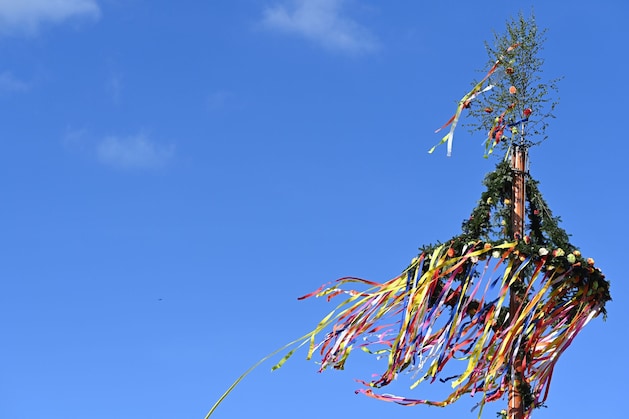There are certain rituals throughout Germany at Pentecost. You can find out exactly what they celebrate and what the background to these customs is here.
When you think of holiday rituals, you immediately think of Christmas. Putting up the Christmas tree, opening presents together, it’s all part of this celebration. But there are also customs on other holidays that have been preserved to this day. Some of these are similar to our Christmas traditions, but some are completely different in nature.
Pentecost trees are visually difficult to distinguish from Maypoles. They are a spruce, fir or birch tree that is cleared of branches up to the top and then decorated with ribbons and flags.
Traditionally, this tree is planted or placed in front of houses where unmarried women live.
In many places, however, the tradition has already merged with the maypole tradition. While in Bavaria the maypole stands for several years, in Lower Saxony the Pentecost tree is put up on the first of May and only remains up until Pentecost.
This ritual is more common in southern Germany. Since the descent of the Holy Spirit is celebrated on Pentecost, the Pentecost fire on this day stands as a symbol of that same spirit or as a sign of purification and enlightenment. If you can’t or don’t want to go to a big fire, bring the Pentecost candle home. This is a large candle that stands burning in the middle of the kitchen table and from which family members can light their own Pentecost candle.
This ritual, which dates back to the Middle Ages, is no longer practiced today. A pigeon made of pine wood or a live pigeon in a cage was lowered on a string through an opening in the church ceiling. There it circled above the heads of the believers. Live pigeons could also be released in the church
A hint of this custom can also be found in Wagner, for example. In Parsifal, at the end of the third act, a white dove floats down and then lingers over his head. In reality, this was a white pigeon in a cage, but these days this instruction is rarely implemented.
Since Pentecost is also a special time for farmers, during so-called Pentecost processions clergymen pronounce blessings on the weather and ask for a good harvest.
This ritual is often held in Swabia. One of the largest processions in all of Europe takes place in Kötzting in the Bavarian Forest.
There are also customs around Pentecost that are older than Christianity. During the Pentecost fountain ritual, fountains are decorated with flowers and birch trunks. In addition, colorful ribbons and painted ones are hung on them.
This ritual goes back to the pre-Christian fertility cult and announces the beginning of summer time. He is best known in Franconia. The ritual can also be traced back to the worship of Germanic spring and well spirits.
In Saarland there is the Whitsun quack ritual, in which children parade through the streets with decorated handcarts. Every now and then they sing a song and are given eggs, bacon or money in return.
The rituals surrounding the Pentecost lout are of different types. On the one hand, the Pentecost lout can be boys who are led around dressed in leaves and are supposed to embody new growth spirits. On the other hand, Pentecost louts also refer to late risers who are immersed in wells as punishment for sleeping for long periods of time. In Switzerland, a Pentecost lout – either a boy dressed in leaves or a doll made from straw, pine branches and moss – is dipped into a fountain and then splashes girls and young women. It is assumed that this originates from fertility rites.
The Pentecost is also an old ritual. Since Pentecost is associated with the beginning of summer, cattle were often brought out to pasture for the first time on Pentecost weekend. The procession was led by a specially decorated ox, which then often had to serve for the Whitsun roast.









